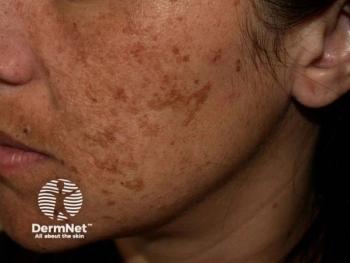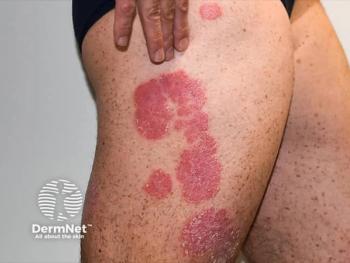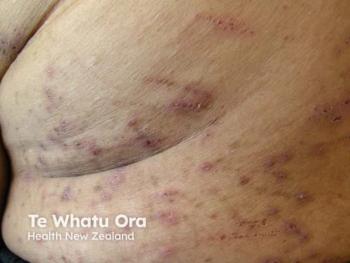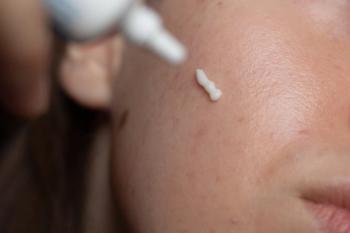
- Dermatology Times, May 2025 (Vol. 46. No. 05)
- Volume 46
- Issue 05
Using Real-World AD Cases to Pick the Right Therapy for Each Patient
Key Takeaways
- Dupilumab was chosen for a 10-year-old with severe AD and asthma due to its systemic benefits, safety profile, and pediatric indication.
- A 24-year-old man with mild AD preferred tapinarof cream for its remittive effect and steroid-sparing potential, aligning with his desire to avoid systemic therapy.
In a recent Dermatology Times Case-Based Peer Perspectives custom video series, Naiem Issa, MD, PhD, reviewed 3 complex patient cases of atopic dermatitis.
In a recent Dermatology Times Case-Based Peer Perspectives custom video series titled
Case No. 1
Issa first reviewed the case of an Asian girl aged 10 years with a long-standing history of moderate to severe AD and comorbid mild asthma. Diagnosed with AD when she was 2, she had previously responded to emollients and topical corticosteroids but experienced worsening flares over the past year, particularly during colder months. Her physical examination revealed erythematous, scaly, excoriated patches on classic AD sites, including the elbows, knees, face, and neck, with notable lichenification.
Despite consistent topical use, including corticosteroids, her condition remained uncontrolled. The disease significantly impacted her quality of life with disruptive sleep, emotional distress, and social embarrassment due to facial involvement. Given the severity, chronicity, comorbidity (asthma), and failure of topical monotherapy, the patient was considered a strong candidate for systemic treatment.
Dupilumab (Dupixent; Sanofi and Regeneron) was selected due to its age-appropriate approval of as young as 6 years and mechanism of action targeting IL-4 and IL-13 via IL-4 receptor alpha blockade. Dupilumab provides systemic immunomodulation without the safety concerns associated with traditional immunosuppressants or systemic corticosteroids. Issa emphasized dupilumab’s favorable safety profile: no boxed warning, no lab monitoring, and low rates of adverse events such as conjunctivitis or arthralgia. Topicals may still be used adjunctively, and for this age group, nonsteroidal options such as tapinarof (Vtama; Dermavant) and roflumilast (Zoryve; Arcutis Biotherapeutics) are viable. Overall, dupilumab was chosen based on its targeted mechanism, pediatric indication, and ability to address systemic atopic disease with minimal safety trade-offs.
Case No. 2
Issa presented a case of an African American man aged 24 years with mild AD and allergic rhinitis. He was diagnosed with AD when he was 8. The patient’s symptoms had been well controlled with emollients and over-the-counter hydrocortisone. However, over the past 6 months, he experienced worsening pruritus and lesion spread to additional flexural sites (elbows, knees, ankles), now involving 5% to 10% of body surface area (BSA). New occupational stress and increased physical activity appeared to be exacerbating factors. Exam findings included dry, hyperpigmented lesions with mild excoriation.
The patient expressed dissatisfaction with his current regimen, citing persistent itch and sleep disturbance. Notably, he preferred to avoid systemic therapy, indicating a desire for an effective topical option.
Given the mild to moderate severity and patient preference, the discussion focused on newer nonsteroidal topical therapies. Among the options—roflumilast 0.15%, ruxolitinib 1.5% (Opzelura; Incyte), and tapinarof 1% cream—the patient chose tapinarof. The patient’s reasoning centered on tapinarof’s remittive effect: Data from clinical trials demonstrate sustained disease control for approximately 83 days after discontinuation. According to Issa, this aligned well with the patient’s desire to reduce application burden and manage flares more effectively over time.
Tapinarof’s mechanism as an aryl hydrocarbon receptor agonist, along with its steroid-sparing potential and efficacy in patients with skin of color, made it a suitable choice. The patient chose treatment with tapinarof cream and achieved favorable results.
Case No. 3
The third case involved a White female hairstylist aged 32 years with asthma, allergic rhinitis, and moderate to severe AD with worsening disease. She has 20% BSA across her hands, elbows, knees, ankles, neck, and face—placing her in the severe category. Her current regimen includes daily emollients and tralokinumab (Adbry; LEO Pharma), which she started 6 months ago, but she reports persistent itch, sleep disruption, and diminished quality of life. Occupational exposure to irritants in the salon environment, especially given her hand involvement, adds complexity to management.
Despite being on a biologic agent, her disease remains uncontrolled, and she expresses a desire to switch therapies while remaining on a biologic. Given her full atopic triad of AD, allergic rhinitis, and asthma, dupilumab was selected as the next-line treatment. According to Issa, its efficacy across the atopic spectrum and specific data from the
Other systemic options, including JAK1 inhibitors (abrocitinib [Cibinqo; Pfizer] and upadacitinib [Rinvoq; AbbVie]), were discussed but declined by the patient. Nemolizumab (Nemluvio; Galderma), an IL-31 inhibitor, lacked the data this patient prioritized. Additionally, ruxolitinib cream was ruled out due to her greater than 20% BSA and the associated boxed warning.
The case discussion also reviewed transitioning between biologics. Clinical trial protocols recommend a 5–half-life washout, but in practice overlapping therapies can be considered, depending on safety profiles and patient burden, according to Issa. In this case, dupilumab was initiated, aiming for broader disease control and occupational relief.
For more AD insights,
Articles in this issue
Newsletter
Like what you’re reading? Subscribe to Dermatology Times for weekly updates on therapies, innovations, and real-world practice tips.


















